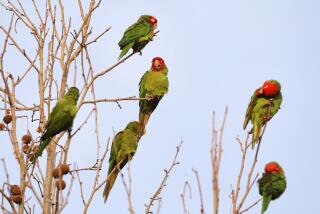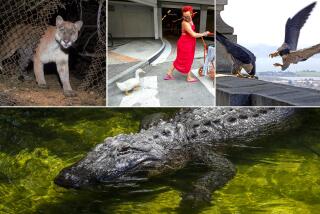Lean and Mean : Trends: Ostrich ranchers say the big, meaty birds may be cash cows of the ‘90s. But neighbors’ feathers are ruffled.
From the vantage point of one angry neighbor, Adam, Eve, Betty and Charlie look like “giant snakes with tennis balls in their mouths.”
All day long, the four ostriches--fated to be slaughtered someday for their lean meat and soft feathers--stretch their necks to peer over a six-foot fence in the back yard of Jack Smith’s Upper Ojai home, spooking the horses at a training ranch next door.
The big birds grunt and gurgle, flap their stubby wings and prance on their skinny legs back and forth in their pen.
Although the ostriches look harmless with their big eyes and long lashes, they have ruffled the feathers of neighboring ranchers, who say they--and their horses--have had enough of the eight-foot-tall, funny-faced beasts.
“Our horses are naturally afraid of the birds,” said Andria Kidd, a horse trainer and Smith neighbor. “The ostriches flap and spook the horses, sending the kids on back of them up like kites.”
Kidd said her boss, Dan Lopez, complained about the birds to the county, saying his neighbors should not be allowed to keep wild animals in their back yard. And at first, county code-enforcement officials agreed and told Smith, 64, to get rid of the birds.
But after a closer review, county officials decided that times have changed. Some Texas ranchers now have large ostrich operations because the bird meat is rich and tasty, low in cholesterol and high in protein.
Code-enforcement officials decided to allow the Smiths to keep the feathered giants, even if they aren’t popular with the horses.
“They’re raised just like cattle,” said Todd Collart, a county planner. “We would not want to consider them wild animals.”
Collart said officials are reworking their animal regulation ordinance to define ostriches as barnyard birds instead of wild animals.
Raising ostriches for their meat is an unusual idea, admitted Smith’s son, Henry.
But he said his family saw a documentary describing the big birds as the cash cows of the ‘90s. The Smiths wanted to be first on the block to get into the growth industry.
The family is certain that ostrich ranching will fly--even if the birds can’t.
“If you can get past the psychological part, the meat is very good,” Henry Smith said. It tastes sort of like veal, only better, he added.
The Smiths built a giant pen on their two-acre lot off the Santa Paula-Ojai Road and purchased the four birds from breeders in Ukiah and Redding in Northern California--at a cost of about $40,000.
They plan to breed the birds--which are fed hay and vitamin-enriched vegetable pellets--and sell the offspring next year for about $3,000 each. With a high-protein diet of ostrich chow, female ostriches are known to lay 40 to 60 eggs in a year.
“It’s being called the fastest-growing agricultural business in the United States,” said Jack Smith. “We’re hoping to make a lot of money. We’re just as optimistic as we can be.”
So far, the optimism has not rubbed off on the neighbors.
“As far as I’m concerned, this is just like the chinchilla market of the ‘50s,” Kidd said, referring to a short-lived rage of raising the soft little critters in back yards to sell for their pricey fur.
Raising ostriches is just a passing fad, Kidd asserted. And besides, she added, who would want to eat ostrich meat anyway?
“There are all kinds of other sources of low-cholesterol meat on the Earth,” Kidd said. “It’s not like this is the only source of it.”
Jack Smith acknowledges that the family is taking a chance.
“It’s a big investment,” he said. “But agriculture is a gamble anyway.”
He said he has heard of some farmers making $100,000 a year raising and selling ostriches, which are hatched in large incubators.
The ostrich craze took off in the United States several years ago. Lured by potential profits, ranchers all over the country--especially in Texas, Oklahoma and the Pacific Northwest--began raising the birds that originated in East Africa.
A decade ago, ostriches could only be found in zoos. Now there are between 4,000 and 8,000 being bred in the United States, says the Fort Worth-based American Ostrich Assn.
At least for a while, the birds will be most valuable as breeding animals. Experts estimate that the ostrich population will have to reach at least 75,000 before it makes economic sense to slaughter them for their hide, feathers and meat.
And ostriches are not the end-all. Their smaller counterpart--an Australian bird called the emu--has also become popular.
Norm Bean has decided to keep two emus as pets in his three-acre yard, visible from California 150 west of Ojai. He said motorists practically drive off the road to get a better look at the birds, who like to stretch their long necks over the fence and pick seeds from the fur of the llamas owned by Bean’s neighbor.
Bean hopes to breed the emus--another bird with the reputation for lean, tender meat--and sell their chicks for $1,000 each.
“I just see it as a chance to make some extra dollars,” said Bean, 52. “Besides, they’re nice pets to have around. They make good watchdogs.”
Contrary to the popular belief that the birds stick their heads in the sand when confronted with danger, ostriches and emus can be downright mean.
Henry Smith said he is very careful not to get too close to the ostriches, which can mount a vicious attack with their legs.
Ostriches have been known to kill humans and animals, including horses, with a swift kick. One large, sharp toenail on each foot can slice like a knife. Plus, the birds can run at a 40-m.p.h. clip, so watch out, Smith said.
“You don’t want to make them mad,” Smith said. “You’ve got to treat them with the proper respect.”
More to Read
Sign up for Essential California
The most important California stories and recommendations in your inbox every morning.
You may occasionally receive promotional content from the Los Angeles Times.










